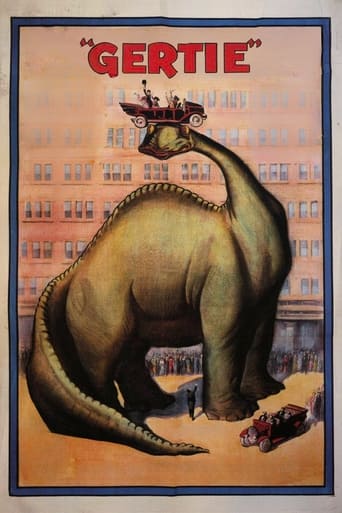gavin6942
The cartoonist, Winsor McCay, brings the Dinosaurus back to life in the figure of his latest creation, Gertie the Dinosaur.McCay first used the film before live audiences as an interactive part of his vaudeville act; the frisky, childlike Gertie did tricks at the command of her master. McCay's employer William Randolph Hearst later curtailed McCay's vaudeville activities, so McCay added a live-action introductory sequence to the film for its theatrical release.Animation historian Donald Crafton called Gertie "the enduring masterpiece of pre-Disney animation". And that about sums it up. The film is relatively simple, and if used live is a pretty basic gimmick. But i bet it worked to impress audiences. If they had never seen a cartoon before 9and they probably had not), this would be quite the treat.
Hitchcoc
This groundbreaking effort is not only a curiosity; it is also a clever, imaginative film. Probably the best known piece of early animation, it involves a minor bet among a group of animators who find themselves at the Museum of Natural History in New York. When they see a dinosaur (they call a dinosaurus--a brontosaurus--although that name is now passé), one of them bets he can bring the dinosaur to life, using animation. The bet for a dinner is accepted and off goes the animator, doing thousands of drawing and creating a truly memorable dinosaur, full of personality and fun. Of course, the main characters are only line drawings on a sketchy setting, it works marvelously. Gertie proves to be petulant and uncooperative at times but, ultimately performs her tricks. I had never seen this film before and am quite impressed with the accomplishment.
bob the moo
Gertie is touted as being one of the first animated films and for its place in cinema history I decided to watch it. Having seen many very ordinary films from the first decade or so of silent film (trains pulling into stations etc) it was fun to see a sense of creativity here. The animator enters a museum and gets into a bet that he can bring a dinosaur to life with his drawing. This he does with the creation of Gertie the Dinosaur and it is not long before he is interacting with her, giving her instructions and, ultimately, entering the frame to ride on her. In a period where even the ordinary was viewed with wonder, it is something to have the creativity to not just animate a dinosaur but do so in a way that sees interaction with real life and in particular see real life enter the film in a way that is perhaps normal a century later – but not then.In terms of the actual film, it is less good than its historical value but is still quite fun. The dinosaur animation is basic for sure, but for me what made the difference was that it is pretty static and repetitive at times – with lots of the dinosaur repeating actions and rocking in a manner that seemed looped. Specific episodes with an elephant and with the creator himself were stronger and offered more, but they were still built around these sections. Perhaps it was because I had just watched a very creative and energetic short film from the same sort of period and this seemed very static next to it.So, not as great as a film to just watch, but it is pretty entertaining and watching it within a historical context will enhance what you are watching.
ackstasis
Often erroneously touted as the first animation film ever made (J. Stuart Blackton's 'An Enchanted Drawing' of 1900 takes that title, at least in America), Gertie the Dinosaur remains, to this day, a charming example of early animation. The live-action segments bookending the animation scenes involve a group of real-life animators portraying themselves, as one of them, Winsor McCay, bets George McManus that he can make a "Dinosaurus" live again by a series of hand-drawn cartoons.Six months – and ten thousand hand-drawn cartoons – later, McCay is ready to show off his hand-made creation. During dinner, McCay introduces his young, playful female Apatosaurus (?) named Gertie. She emerges somewhat tentatively from her cave, before proceeding to swallow a rock and then an entire tree. As McCay gives her instructions from off-screen, Gertie attempts to follow them, though her endless enthusiasm for mischief often leads her master to scold her. Gertie's playful persona is further explored when Jumbo, a passing Woolly Mammoth, threatens to steal her limelight. Though warned not to hurt the little creature, Gertie doesn't hesitate in picking up poor Jumbo by the tail and hurling him into the lake.McCay's vision of a dinosaur – allegedly the first time that one had appeared on film – is a little scientifically shaky (I don't expect any dinosaurs to have been able to dance on their hind legs for any prolonged period of time), but I'm more than willing to forgive this in such an early film. What is a Woolly Mammoth doing back then, you may even find yourself asking? The trick is to completely shut out what we all know more than ninety years later, and to just appreciate what a stunning achievement this piece of animation actually was.Just as the film explicitly states, the animation of Gertie required about ten thousand hand-drawn images (by both McCay and his assistant, John A. Fitzsimmons, who traced the backgrounds), which they inked on rice paper and mounted on cardboard. In the film, it took McCay six months. But, we might ask, shouldn't he have wagered something a little more valuable than just a single dinner? George got off easy, I say!



